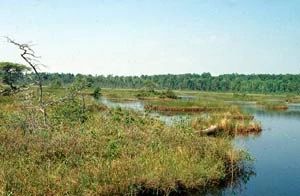Bark Bay Slough
No. 137

Photo by E. Epstein
Bark Bay Slough consists of a coastal barrier spit, lagoon, springs, and wetlands occupying an embayment between two rocky headlands along Lake Superior. The wetlands are extensive and include two major types: coastal fen and coastal bog. The fen dominants are woolly sedge, twig rush, sweet gale, water horsetail and buckbean .
The coastal bog is composed of a mat of Sphagnum mosses, ericaceous shrubs, sedges, carnivorous plants and scattered small tamarack. Both communities are floristically diverse, in excellent condition, and support many rare species. A forested interior sand spit parallel to the coastal barrier spit (or 'bay-mouth bar') breaks the wetlands into two major sections. The sandy, 2-mile-long barrier spit contains red pine and white pine with an understory of blueberry, bearberry, alder, sweet gale, and beach grasses.
A large lagoon occupies the center of the site and supports submergence and floating-leaved aquatic plants. Together, the wetlands and 28-acre lagoon form a bay-mouth bar lake. The shallow (8-foot maximum depth), hard water lake supports mostly panfish and northern pike. The Bark River, and a spring complex on the eastern end of the natural area supply water to the lake and wetlands. Birds present during the breeding season include bald eagle, sandhill crane, Brewer's blackbird, and American bittern. Substantial numbers of migrating shorebirds make use of the property. Bark Bay Slough is owned by the DNR and was designated a State Natural Area in 1977.
Very few State Natural Areas have public facilities, but nearly all are open for a variety of recreational activities as indicated below. Generally, there are no picnic areas, restrooms, or other developments. Parking lots or designated parking areas are noted on individual SNA pages and maps. Trails, if present, are typically undesignated footpaths. If a developed trail is present, it will normally be noted on the SNA map and/or under the "Access" tab. A compass and topographic map or a GPS unit are useful tools for exploring larger, isolated SNAs.
The good majority of SNAs are isolated and have few or no facilities. Some SNAs have vehicle access lanes or parking lots, but their accessibility may vary depending on weather conditions. Parking lots and lanes are not plowed during winter. Hiking trails may be nonexistent or consist of undeveloped footpaths. A GPS unit or compass and a detailed topographic map are useful tools for exploring larger SNAs.
Entrance fees: Excepting Parfrey's Glen, the Cambrian Outlook in the Dells of the Wisconsin River, SNAs within State Parks and some within State Forests, all other DNR-owned SNAs do not have any admission fees. For more information, see Wis. Admin. Code NR 45. For non-DNR-owned SNAs, we are unaware of any vehicle or admission fees. However, please contact the landowner for more information.
NOTE: Per state regulations, hunting is allowed on the DNR-owned SNA lands. However, on lands located within the Village of Rock Springs (see map), the discharge of firearms is prohibited within the village limits. See their Village Ordinance Chapter 4 [exit DNR] for details.
ALLOWABLE ACTIVITIES: DNR-OWNED LAND
The activities listed below are generally allowed on all DNR-owned SNA lands. Exceptions to this list of public uses, such as SNAs closed to hunting, are noted above and posted with signs on the property site.
- Hiking
- Fishing
- Cross country skiing
- Hunting
- Trapping
- Scientific research (permit required)
- Outdoor education
- Wild edibles (What is this?)
- Pets (Rules)
- Wildlife viewing
PROHIBITED ACTIVITIES: ALL SNAS
- Camping and campfires
- Collecting of animals (other than legally harvested species), non-edible fungi, rocks, minerals, fossils, archaeological artifacts, soil, downed wood, or any other natural material, alive or dead.
- Collecting for scientific research requires a permit issued by the DNR
- Collecting of plants including seeds, roots or other non-edible parts of herbaceous plants such as wildflowers or grasses
- Geocaching
- Horseback riding
- Rock climbing
- Vehicles, including bicycles, ATVs, aircraft, and snowmobiles except on trails and roadways designated for their use.
For rules governing state-owned SNAs and other state lands, please consult Chapter NR 45 Wis. Admin. Code [exit DNR].
Location
Bayfield County. T50N-R7W, Sections 1, 2. T51N-R7W, Sections 35, 36. 646 acres.
Driving directions
From Herbster, go northeast on State Highway 13 for 3.5 miles, then north and west on Bark Bay Road for 0.5 miles to a boat landing east of the road. The best access to the sand spit and bog is by canoe.
The DNR's state natural areas program is comprised of lands owned by the state, private conservation organizations, municipalities, other governmental agencies, educational institutions and private individuals. While the majority of SNAs are open to the public, access may vary according to individual ownership policies. Public use restrictions may apply due to public safety, or to protect endangered or threatened species or unique natural features. Lands may be temporarily closed due to specific management activities.
Users are encouraged to contact the landowner for more specific details. The data shown on these maps have been obtained from various sources, and are of varying age, reliability, and resolution. The data may contain errors or omissions and should not be interpreted as a legal representation of legal ownership boundaries. To create your custom map where you can zoom to a specific location, please use the DNR's Mapping Application.
Bark Bay Slough is owned by: Wisconsin DNR
